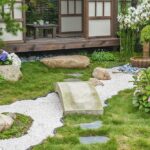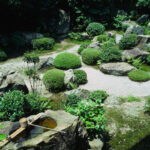Japanese garden design is a unique and intricate art form that has been developed over centuries. These gardens are known for their serene beauty, meticulous attention to detail, and harmonious balance of elements. The design of Japanese gardens is deeply rooted in cultural and religious traditions, and each garden is carefully planned and constructed to mimic the natural beauty of the Japanese landscape.
One of the key principles of Japanese garden design is the concept of “wabi-sabi,” which emphasizes simplicity, imperfection, and transience. This principle is reflected in the use of natural materials such as rocks, gravel, and plants, as well as in the careful placement of objects to create a sense of harmony and balance. Japanese gardens are often designed to be viewed from a specific vantage point, such as a tea house or sitting area, in order to fully appreciate the beauty of the garden.
Another important element of Japanese garden design is the use of symbolism and metaphor. Many elements in a Japanese garden, such as rocks, water, and plants, are used to represent specific qualities or emotions. For example, water is often used to represent the flow of life, while rocks may symbolize strength and stability. By incorporating these symbolic elements into the design of the garden, the designer is able to create a space that is not only visually appealing, but also imbued with deeper meaning and significance.
Japanese gardens are also known for their meticulous attention to detail and precision. Every element in a Japanese garden, from the placement of rocks and plants to the arrangement of pathways and water features, is carefully considered and planned. This attention to detail helps to create a sense of order and serenity in the garden, and allows visitors to fully immerse themselves in the beauty of the space.
In addition to their aesthetic beauty, Japanese gardens are also designed to evoke a sense of tranquility and peace. The careful placement of elements, the use of natural materials, and the incorporation of symbolism all work together to create a space that is both visually stunning and spiritually uplifting. Visitors to a Japanese garden are encouraged to slow down, contemplate the beauty of nature, and find a sense of inner peace and harmony.
Overall, Japanese garden design is a fine art that has been refined and perfected over centuries. These gardens are not only a reflection of the natural beauty of Japan, but also a reflection of the cultural and spiritual beliefs of the Japanese people. By incorporating elements of simplicity, symbolism, and precision, Japanese gardens are able to create spaces that are not only visually stunning, but also deeply meaningful and spiritually enriching.
















